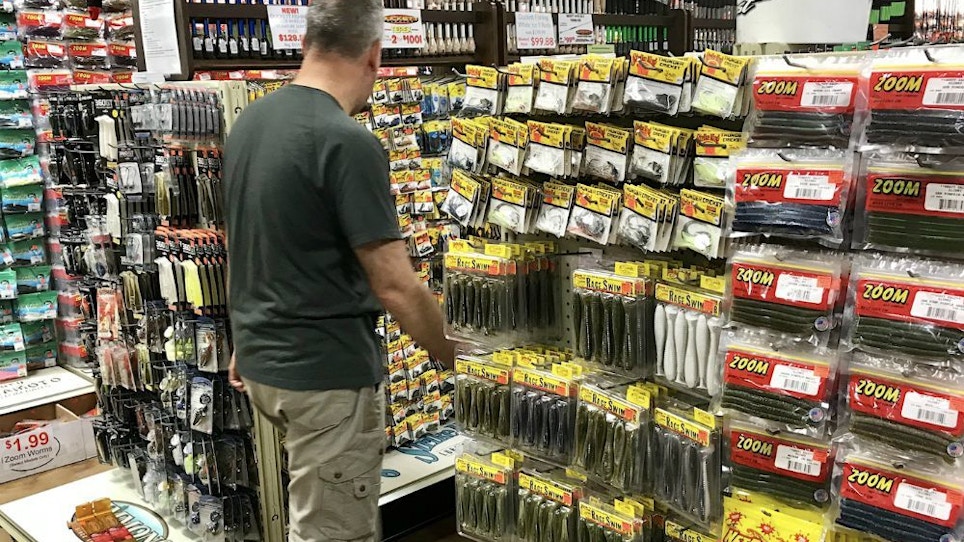
If you added products that are not performing well, perhaps fishing items to try to tap into extra sales, now might be the time to have a blowout sale and readjust your strategy. (Photo: Alan Clemons)
One thing the COVID-19 pandemic has done for companies and retailers is force them to rethink strategies about what's on the shelf.
Having inventory that doesn't sell is not good at any time. Moving underperforming or out-of-season merchandise is nothing new. Sales bins, holiday blowouts, Black Friday deals, "Everything Must Go!" wipeouts and even the good ol' Dollar Table where everything's a buck are common strategies.
But even with those tried-and-true methods buyers still see bins they pick through, maybe find an old lure or riflescope or shirt, and they ignore the rest. The next time they're in the shop that same stuff is there. And the next, and the next and so on.
I always dig through the bargain bins and Dollar Tables, especially for fishing lures and camo. I've found certain lures that I like marked down to get rid of them and I buy all of them. I keep a go-bag of clothes in my truck, and cheap camo gets the nod for a quick hunt or if I forget something.
But now, it's essential to have the best available items that will generate revenue in your stores. And that means getting rid of the underperforming products to make room for what you know will sell.
Wait, What?
How do you do that? By literally removing products that don't sell. That sounds radical but these are somewhat radical times. You won't be the only company or retailer doing this, too.
The Wall Street Journal reported that some IGA grocery stores now offer four brands of toilet paper whereas pre-corona its 1,100 stores had about 40 varieties. Harley Davidson has cut some of its models. Outback Steakhouse trimmed 40 percent of its menu and is considering doing more.
Bombardier Recreational Products has ended production of Evinrude E-TEC and E-TEC G2 outboard engines. Remington reportedly is amid possible bankruptcy restructuring and purchase (out of bankruptcy) by the Navajo Nation, which could make major changes to its models. Remington already has put DPMS and Bushmaster in dormancy.
Those are major companies with giant sums of money, you might argue. But everything is relative. And when you're sitting on a batch of items gathering dust, it's time to make changes.
The first thing to do is look at what is selling well and what is just sitting there doing nothing. That means walking through yours store, talking with your employees and checking your sales records. Some things may not be hard to figure out. Others, perhaps, you haven't thought about or realized how long they'd been on a shelf with a price that a buyer wouldn't dream of paying.
Obviously you have to look at what the items cost you and what you want out of it. But something is better than nothing, right? A few dollars is better than zero dollars. Remember the Dollar Table? Crazy's Eddie's Outdoor Blowout Extravaganza might not be a bad idea, too.
A few years ago in Illinois on a deer hunt we stopped by Scheels All Sports. As we were wandering around the store I spotted a bin of blaze orange caps for $5 each with the store logo. They fit well and I liked it. Remember my truck go-bag? I bought four caps.
And I remember years ago a tackle shop in south Alabama that sponsored a late summer fishing tournament for grinnel. Yes, grinnel, also known as mudfish, choupique and bowfin. The shop put on its big sale table some of the ugliest lures that didn't sell. The store got some name recognition with the tournament, anglers caught bunches of mean grinnel, and the store racked up sales. Win, win.
The Scheels cap sale table was a cheap marketing stragety but it worked. Mark's Outdoors in Birmingham did the same thing for years with inexpensive cotton t-shirts. The point is that the price is low enough that instead of me thinking about buying one, I'm thinking about buying four or five. If I lose it or it gets dirty, big deal. If I get two or three years (or more) out of a $5 cap or shirt, that's a bargain. And the store got my money.
Whether you have grips and stocks, ammo, lures, camouflage, old deer scents, arrows or other items, don't let it collect dust. You're not running an antique store. Make a change and generate sales.





